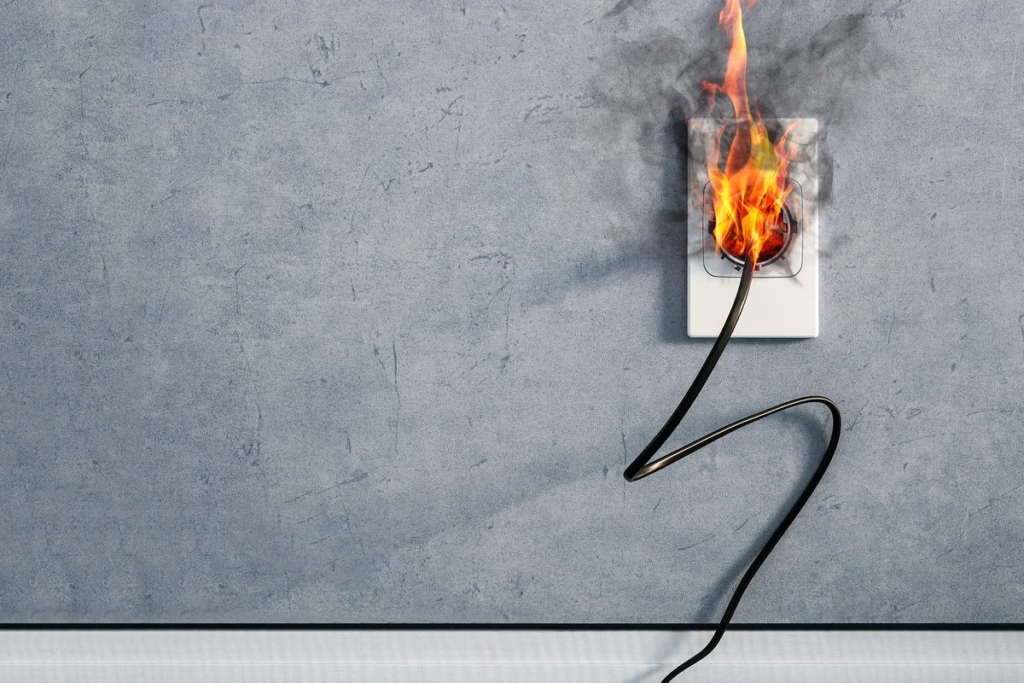Electrical cords are essential in every workplace, from office spaces to construction sites. However, improper use, wear and tear, and neglect can turn them into serious safety hazards. Faulty electrical cords can lead to fires, electric shocks, and workplace injuries, potentially causing severe damage or even fatalities. Understanding these risks and how to prevent them is crucial for maintaining a safe working environment.
In this guide, we’ll explore the most common hazards associated with electrical cords in the workplace and how to mitigate them effectively while following California workplace safety regulations.
Common Electrical Cord Hazards in the Workplace
Faulty electrical cords are responsible for thousands of workplace injuries every year. Here are the most common dangers they pose:
1. Frayed or Damaged Cords
Over time, electrical cords deteriorate due to wear and tear, exposure to heat, or accidental cuts.
Exposed wires increase the risk of electrical shocks and short circuits, leading to potential fires.
OSHA requires employers to replace damaged cords immediately to prevent injuries.
2. Overloaded Circuits
Plugging too many devices into a single cord can overload the circuit, leading to overheating and fire risks.
Extension cords should not be used as permanent wiring solutions.
Use surge protectors and ensure circuits are not exceeding their rated capacity.
3. Improper Placement of Cords
Cords running across walkways or work areas can create tripping hazards.
Cords under carpets or furniture can overheat and deteriorate, posing a fire risk.
Proper cord management solutions, such as cable trays and cord covers, should be used to prevent accidents.
4. Using the Wrong Type of Cord
Using indoor-rated cords for outdoor applications can lead to moisture damage and electrical failure.
Some workplaces require heavy-duty cords with grounding for power tools and industrial equipment.
Always check the cord’s rating, voltage, and insulation type before use.
5. DIY Repairs and Temporary Fixes
Taping over a frayed cord or using makeshift repairs does not make it safe for use.
Exposed wires or improper splicing can cause electric shocks and fire hazards.
Only qualified electricians should repair or replace damaged cords.
6. Water Exposure & Electrical Cords
Using electrical cords near wet surfaces or in damp conditions can lead to electrocution.
Worksites should use GFCI-protected outlets to cut power in case of electrical faults.
Keep all electrical cords and equipment away from water sources.
California Workplace Safety Regulations for Electrical Cords
The California Occupational Safety and Health Administration (Cal/OSHA) enforces strict electrical safety standards to protect workers from preventable hazards. Here are key regulations employers must follow:
Cal/OSHA Title 8, Section 2510.5: Employers must ensure all electrical cords are in good condition and properly rated for the work environment.
Cal/OSHA Title 8, Section 3314: Outlines lockout/tagout procedures to prevent electrical injuries during maintenance.
National Electric Code (NEC) Compliance: Requires workplaces to use the correct type of cords and install GFCIs in hazardous locations.
Failure to comply with these regulations can result in heavy fines and legal liabilities. Ensuring workplace electrical safety isn’t just a best practice—it’s the law.
How to Prevent Electrical Cord Hazards
To maintain a safe and OSHA-compliant workplace, follow these key safety measures:
Regular Inspections: Check electrical cords for frays, cuts, or signs of overheating.
Proper Storage: Avoid twisting or coiling cords tightly, as this can damage internal wiring.
Use the Right Cord: Ensure cords are rated for the voltage and environment they’re used in.
Never Overload Outlets: Distribute power loads across multiple circuits to prevent overheating.
Professional Electrical Safety Audits: Have an expert inspect workplace electrical systems regularly.
When to Call a Professional
Some electrical hazards require immediate professional attention. Contact Advanced Restoration & Construction if:
You notice burning smells, flickering lights, or sparks from electrical outlets.
There are frequent power surges or circuit breaker trips.
You need an OSHA-compliant electrical safety assessment for your workplace.
Faqs
No, OSHA states that extension cords are only for temporary use. Long-term wiring solutions should be installed by a licensed electrician.
Workplace electrical cords should be inspected before each use and formally reviewed by a professional every 6 to 12 months.
No, using electrical tape as a permanent fix is unsafe. It’s best to replace or professionally repair damaged cords.
Stop using it immediately and report it to workplace maintenance or safety officers.
Yes, especially if you work in high-risk environments like construction, manufacturing, or healthcare. Routine inspections help prevent costly damage and OSHA violations.

